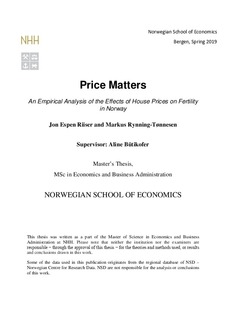Price matters: an empirical analysis of the effects of house prices on fertility in Norway
Master thesis
Permanent lenke
http://hdl.handle.net/11250/2609942Utgivelsesdato
2019Metadata
Vis full innførselSamlinger
- Master Thesis [4372]
Sammendrag
Since the late 1970s, the fertility rate in Norway has been relatively stable, slightly below replacement
level. After a peak in 2009, fertility has declined, and in 2018 it dropped to the lowest level ever
recorded. At the same time, house prices have more than doubled since the turn of the millennium.
Recent literature has investigated how variation in house prices has contributed to changes in fertility
in other countries. Against this backdrop, this thesis aims to answer the question “Do house prices
affect fertility in Norway?”
We construct a panel data set by obtaining data on fertility, house prices, ownership, and controls at
a labour market level from 2003 to 2018. Our main specification is an OLS model regressing current
period fertility on house prices and the interaction between house prices and ownership rates,
controlling for economic covariates and fixed effects. We extend our analysis by introducing a set of
alternative specifications.
We find that for a NOK 1,000 increase in price per square metre, fertility decreases 7.2 per cent, while
the effect of the interaction with ownership is a 9 per cent increase. These coefficients are statistically
significant individually, and in sum. However, the economic significance at the average ownership level
is small, as the net effect is only a 0.2 per cent increase. Our findings are consistent with previous
literature finding different effects for owners and non-owners in other countries, but the magnitude
of our net effect is smaller. The significance of the main results are robust across most alternative
specifications. A heterogeneity analysis reveals that the result seems to be driven by women between
the ages of 30 and 49. Our findings imply that changes in house prices might redistribute fertility
between groups depending on ownership, but that the net effect on aggregate fertility is small.
